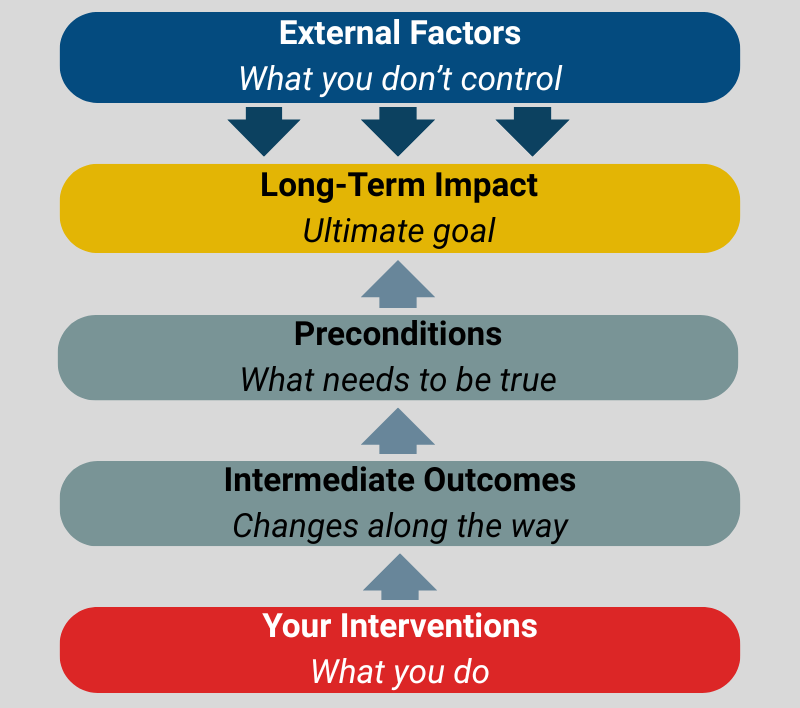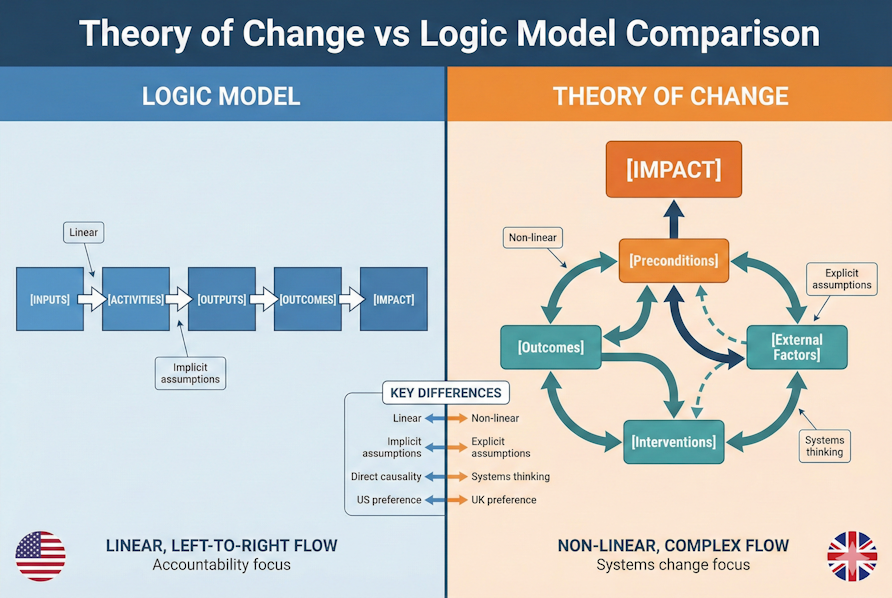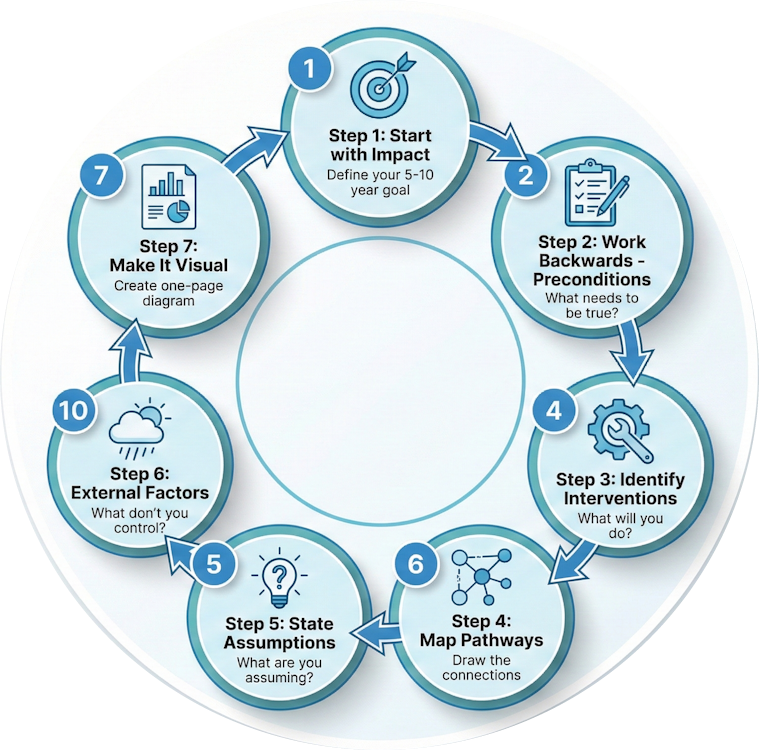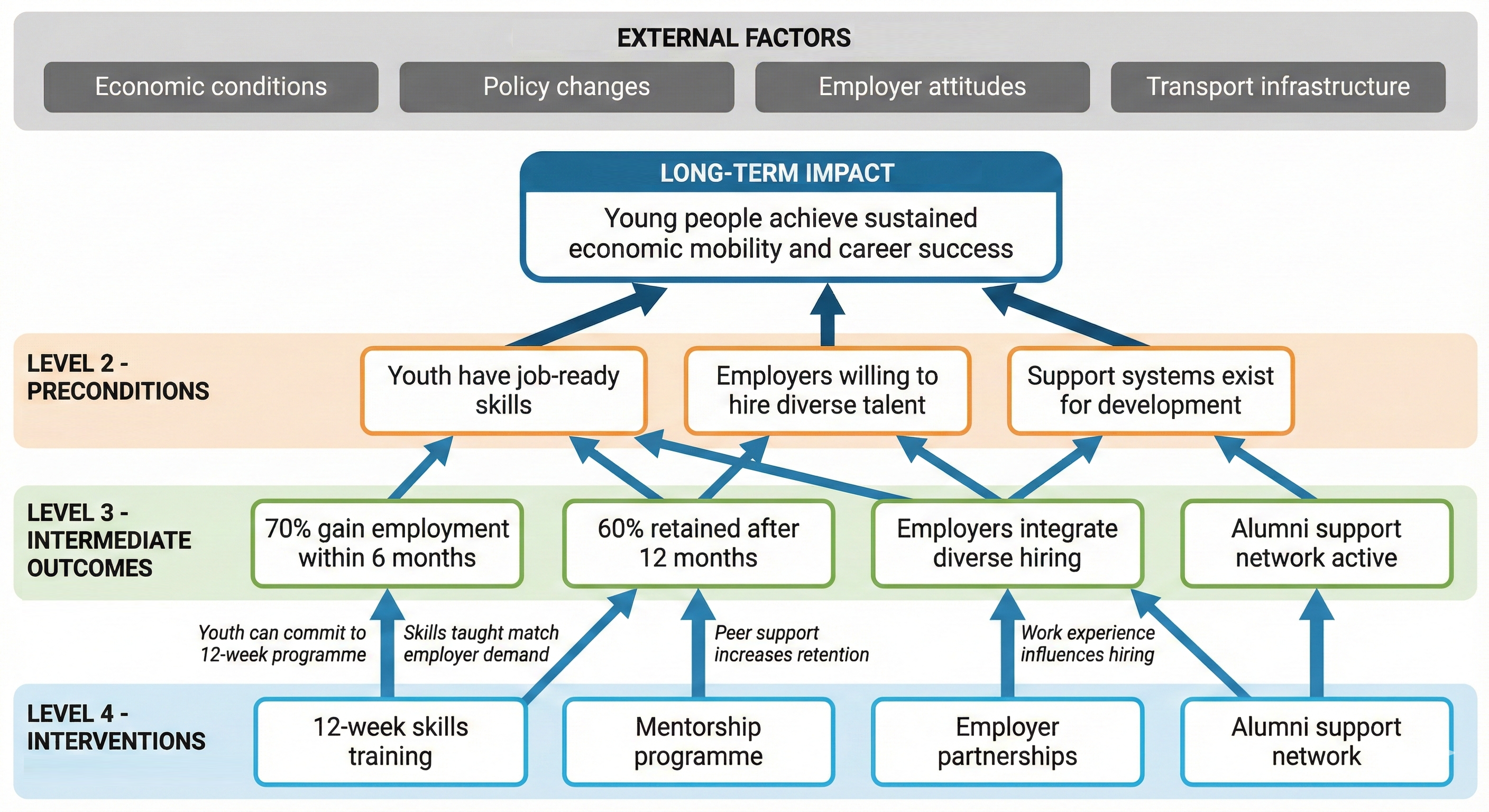If you've ever submitted a grant application to a major UK trust or foundation, you've likely encountered the dreaded requirement: "Please include your Theory of Change." For many charities, this request triggers panic. What exactly is a Theory of Change? How is it different from a logic model? And how do you create one that actually strengthens your application?
You're not alone in this confusion. Theory of Change has become the gold standard for UK funders—especially larger trusts and foundations—yet most charities struggle to develop one effectively. The good news? Once you understand the framework, a well-crafted Theory of Change can transform not just your grant applications, but your entire strategic approach.
In this comprehensive guide, you'll learn exactly what a Theory of Change is, why UK funders prefer it, how it differs from a logic model, and most importantly, how to build one step-by-step for your organisation. Plus, we'll provide you with a free downloadable template to make the process easier.

Tired of low grant success rates? Our AI helps UK charities write winning applications 4x faster.
AI Grant writing with Data Privacy by default
What is a Theory of Change?
Clear Definition
A Theory of Change (ToC) is a comprehensive framework that maps out how and why a desired change is expected to happen in a particular context. Unlike simpler planning tools, a Theory of Change acknowledges complexity, makes assumptions explicit, and recognises that real-world change rarely follows a straight line.
At its core, a Theory of Change shows the pathway between your activities and your long-term impact, whilst openly acknowledging the external factors and conditions that influence success. It's not just about what you'll do—it's about understanding the entire ecosystem of change.
The Purpose of Theory of Change
Theory of Change serves three critical purposes:
- Strategic clarity – It forces you to think deeply about how change actually happens in your field, not just what activities you'll deliver.
- Honest assessment – By making assumptions explicit, you can test whether your theory is sound and identify potential weaknesses before you invest resources.
- Transparent communication – It shows funders that you understand complexity and have thought rigorously about your approach.
Theory of Change in Grant Applications
In grant applications, a Theory of Change demonstrates sophistication. It tells funders:
- You understand that change is complex and non-linear
- You've thought about the broader context, not just your programme
- You're honest about what you can and cannot control
- You've identified the preconditions necessary for success
- You're willing to state—and test—your assumptions
Why UK Funders Love Theory of Change
UK funders, particularly larger trusts and foundations, have increasingly adopted Theory of Change as their preferred framework for several reasons:
- Systems thinking – UK funders often support work addressing complex social issues that require multi-stakeholder approaches
- Long-term impact – Theory of Change is ideal for programmes aimed at sustainable, systemic change rather than short-term outputs
- Learning orientation – By making assumptions explicit, ToC enables both funders and charities to learn what works
- Accountability with nuance – It holds organisations accountable whilst acknowledging real-world complexity
Major UK funders including the National Lottery Community Fund, Esmée Fairbairn Foundation, and many community foundations now request or recommend Theory of Change in their applications.

Theory of Change vs Logic Model
One of the most common sources of confusion for grant writers is understanding the difference between a Theory of Change and a logic model. Both are frameworks for planning and evaluation, but they serve different purposes and are preferred in different contexts.
Key Differences Explained
Logic models are linear, accountability-focused tools that map a straightforward path from inputs through to impact. They work on a simple if-then premise: "If we do X, then Y will happen." Logic models are excellent for direct service programmes with clear, measurable outcomes.
Theory of Change is a complex, non-linear framework that acknowledges multiple pathways to impact and the external factors that influence success. It operates on systems-thinking: "If we do X in context Y, then Z becomes possible—assuming A, B, and C are true."
When to Use Theory of Change
Theory of Change is the right choice when:
- Applying to UK foundations – Especially larger trusts that request ToC explicitly
- Addressing complex problems – Systemic issues with multiple stakeholders and interconnected causes
- Planning systems change work – Programmes that aim to shift community conditions, policies, or norms
- Pursuing long-term impact – Initiatives where change unfolds over years, not months
- Operating in uncertain contexts – Where external factors significantly influence outcomes
When to Use Logic Model
Logic models remain valuable for:
- US foundation and government grants – Logic models are the standard in American grantmaking
- Direct service programmes – Clear, time-bound interventions with measurable outputs
- Programme evaluation – When you need to demonstrate direct causality and accountability
- Internal planning – Simple, visual tool for programme design
Stay updated on new funding opportunities
Get daily notifications about new funders, programme changes, deadline updates, and funding opportunities delivered to your inbox.
Can You Use Both?
Absolutely! Many organisations develop a Theory of Change for strategic planning and use logic models for specific programmes within that broader theory. You might also present a Theory of Change in narrative form and include a logic model diagram to show your specific programme's structure.
Side-by-Side Comparison
Here's how the same project looks through both frameworks:
Example: Youth Employment Programme
Logic Model Version:
- Inputs: Staff, curriculum, employer partners
- Activities: Job readiness training, internships
- Outputs: 50 youth complete programme
- Outcomes: 70% employed within 6 months
- Impact: Reduced youth unemployment in community
Theory of Change Version:
- Long-term impact: Youth economic mobility and career success
- Preconditions: Employers willing to hire from this demographic, youth have job-ready skills, youth have confidence and professional networks, systemic barriers addressed
- Interventions: Technical training + work experience + mentorship + employer engagement
- Assumptions: Local labour market has entry-level opportunities, transportation is accessible, youth are motivated to participate
- External factors: Economic conditions, immigration policy, employer attitudes, competing opportunities
| Logic Model | Theory of Change | |
|---|---|---|
| Structure | Linear, left-to-right | Non-linear, complex pathways |
| Focus | Accountability and outputs | Systems thinking and change |
| Assumptions | Implicit (assumed but not stated) | Explicit (stated and testable) |
| External factors | Not typically included | Central to the framework |
| Best for | Direct service programmes | Complex, systemic change |
| Common in | US grants | UK grants |
| Time horizon | Short to medium term | Medium to long term |
| Complexity | Simpler, more accessible | More sophisticated, requires deeper thinking |

How to Build a Theory of Change (Step-by-Step)
Creating a Theory of Change might seem daunting, but following a structured process makes it manageable. This is the most important section—your practical, actionable guide to building a Theory of Change from scratch.
Step 1: Start with Your Long-Term Goal (Impact)
Begin at the end. What ultimate change do you want to see in 5-10 years? This isn't about your organisation's activities—it's about the transformation you're working toward in your community or for your beneficiaries.
Be ambitious but specific:
- ❌ Too vague: "Improve community wellbeing"
- ✅ Clear impact: "Youth from disadvantaged backgrounds achieve economic mobility and sustained career success"
Questions to ask:
- What would success look like if your organisation achieved everything it set out to do?
- What would be different in your community or for your beneficiaries?
- How would you know you've achieved transformational change?
Step 2: Work Backwards – What Are the Preconditions?
This is where Theory of Change differs most from simple programme planning. Ask yourself: what needs to be true for that long-term impact to happen? These are your preconditions—the necessary conditions that must exist for your goal to be achieved.
For the youth employment example, preconditions might include:
- Youth have job-ready technical skills
- Employers are willing to hire from this demographic
- Youth have confidence and professional networks
- Systemic barriers (transport, childcare, discrimination) are addressed
- Entry-level job opportunities exist locally
List 3-5 necessary preconditions. Don't worry about what your organisation will do yet—focus on what needs to be true in the world.
Step 3: Identify Your Interventions (Activities)
Now you can think about your organisation's role. Which preconditions will you address? What's your unique contribution to creating these conditions?
Be realistic about your sphere of influence:
- You might directly address "youth have job-ready skills" through training
- You might partially influence "employers willing to hire" through engagement work
- You probably can't address "entry-level jobs exist locally" (that's an external factor)
Example interventions:
- Provide technical training in digital marketing and customer service
- Facilitate work experience placements with local employers
- Deliver mentorship programme connecting youth with professionals
- Offer job search support and interview preparation

Step 4: Map the Pathways
How do your interventions lead to your preconditions? How do those preconditions connect to your long-term impact? What are the intermediate outcomes along the way?
Think through the causal chain:
Training → Youth develop skills → Youth gain confidence → Youth secure interviews → Youth obtain jobs → Youth achieve economic stability → Youth achieve long-term economic mobility
This is where visual mapping becomes essential. You're drawing the connections between your activities and your ultimate goal, showing the intermediate steps.
Step 5: State Your Assumptions
This is what makes Theory of Change powerful: explicitly naming what you're assuming to be true. Every theory of how change happens is built on assumptions. By stating them openly, you can test them and adjust your approach if they prove false.
Examples of assumptions:
- "We assume the local economy will have entry-level job openings in the sectors where we provide training"
- "We assume youth are motivated to participate in a 12-week programme"
- "We assume employers value work experience and training certificates over formal qualifications"
- "We assume that gaining employment leads to improved economic outcomes (rather than just low-wage, insecure work)"
For each major element of your theory, ask: "What would need to be true for this to work?"
4x
Faster grant writing
Tired of low grant success rates?
Our AI helps UK charities write winning applications.
Step 6: Identify External Factors (What You Don't Control)
External factors are the conditions and forces outside your control that could help or hinder your work. Being honest about these shows funders you understand the broader context.
Common external factors:
- Economic conditions – Recession, labour market trends, local industry changes
- Policy changes – Government funding, employment law, immigration rules
- Social factors – Community attitudes, discrimination, cultural norms
- Environmental factors – Funding landscape, competing services, demographic shifts
You're not making excuses—you're demonstrating strategic thinking. Acknowledging that your programme operates within a larger system shows sophistication, not weakness.
Step 7: Make It Visual
A Theory of Change should ultimately be represented as a one-page diagram that shows:
- Your long-term impact at the top or right
- Preconditions that lead to that impact
- Your interventions/activities
- The pathways connecting them (arrows showing causality)
- Assumptions noted alongside the pathways they relate to
- External factors shown in a separate box or around the edges
Visual mapping tips:
- Use different shapes or colours for different elements (interventions vs. preconditions vs. impact)
- Include a clear legend
- Make arrows show direction of causality
- Don't overcomplicate—simpler is better
- Test whether someone unfamiliar with your work can follow the logic

Process Tips for Building Your Theory of Change
Do this as a team workshop, not solo. Theory of Change is most powerful when developed collaboratively. Include programme staff, trustees, and importantly, beneficiaries and partner organisations. Different perspectives will strengthen your theory.
Start messy, refine later. Use sticky notes on a wall before creating a polished diagram. Move things around. Question connections. Debate assumptions. The messiness is part of the process.
Expect to revise multiple times. Your first Theory of Change will evolve as you test it against reality. That's not a failure—that's learning. Build in annual reviews to refine your theory based on experience.
Don't confuse it with a work plan. Theory of Change is higher-level than project planning. It's about the logic of how change happens, not the detailed activities you'll undertake.
Theory of Change Examples for UK Charities
Let's look at three realistic examples that show how different types of charities might structure their Theory of Change.
Example 1: Youth Employment Charity
Long-term impact: Young people from disadvantaged backgrounds achieve sustained economic mobility and career progression
Key preconditions:
- Youth possess in-demand technical skills
- Youth have professional confidence and soft skills
- Employers recognise and value diverse talent
- Entry-level career pathways are accessible
- Support networks exist for ongoing development
Interventions:
- 12-week digital skills training programme
- Workplace mentoring and job shadowing
- Employer engagement and partnership development
- Ongoing alumni support network
Key assumptions:
- Youth can commit to a 12-week programme
- Local employers have entry-level opportunities
- Skills taught match employer demand
- Work experience influences hiring decisions
External factors:
- Local economic conditions and unemployment rates
- Employer attitudes toward young people from disadvantaged backgrounds
- Availability of public transport to work locations
- Competition from other training providers
Example 2: Community Health Initiative
Long-term impact: Residents of underserved neighbourhoods experience improved health outcomes and reduced health inequalities
Key preconditions:
- Community members have health knowledge and skills
- Healthcare services are accessible and culturally appropriate
- Social determinants of health are addressed (housing, income, environment)
- Community has strong social networks and peer support
- Health system is responsive to community needs
Interventions:
- Train community health champions
- Facilitate peer support groups for chronic conditions
- Advocate with local NHS trust for improved services
- Connect residents with benefits and social services
Key assumptions:
- Peer support influences health behaviours
- Community members trust health champions from their own community
- NHS services will respond to advocacy
- Addressing social needs improves health outcomes
External factors:
- NHS funding and service availability
- Local authority budget for social care
- Housing policy and availability
- National health policy changes
Example 3: Environmental Conservation Group
Long-term impact: Local ecosystems are restored and resilient, with community-led stewardship ensuring sustainability
Key preconditions:
- Native habitats are protected and expanded
- Pollution and invasive species are controlled
- Community members value and engage with nature
- Local policies support conservation
- Funding exists for ongoing management
Interventions:
- Habitat restoration projects (tree planting, wetland creation)
- Community education and volunteer programmes
- Policy advocacy with local council
- Partnership with landowners and businesses
Key assumptions:
- Habitat restoration leads to biodiversity increase
- Community involvement creates long-term stewardship
- Local council will adopt conservation-friendly policies
- Climate change impacts can be mitigated through local action
External factors:
- Climate change and extreme weather events
- National planning policy and development pressure
- Local authority priorities and budget
- Landowner cooperation
Using Theory of Change in Grant Applications
Creating a Theory of Change is valuable for your organisation's strategy, but it's also a powerful tool in grant applications. Here's how to use it effectively.
Where to Include Your ToC in Proposals
Visual diagram: Include a one-page visual Theory of Change as an appendix or embedded in the project description section. Make sure it's clear and readable.
Narrative explanation: Don't just attach the diagram—walk reviewers through your logic in the main text. Explain each element and why you believe the connections hold true.
Throughout the proposal: Reference your ToC when discussing activities ("As shown in our Theory of Change..."), evaluation ("We will test the assumption that..."), and sustainability ("Our theory acknowledges the external factors that...").
How to Write About Your Theory of Change
Use clear, confident language that shows strategic thinking:
✅ "Our Theory of Change recognises that youth employment requires both skills development and employer attitude change. Our programme addresses both through..."
✅ "We assume that peer support influences health behaviour change more effectively than top-down advice. This assumption is supported by [evidence] and will be tested through..."
✅ "Our theory acknowledges external factors beyond our control, including economic conditions and policy changes. Our approach builds resilience by..."
Common Mistakes to Avoid
❌ Making it too complex – If your diagram needs tiny font or covers three pages, simplify. Complexity should be in your thinking, not your presentation.
❌ Hiding your assumptions – Don't be afraid to state assumptions openly. Transparency builds trust.
❌ Ignoring external factors – Pretending you control everything shows naivety, not confidence.
❌ Confusing ToC with a work plan – Theory of Change is about the logic of change, not a detailed activity schedule.
❌ Creating it just for the grant – If your ToC doesn't genuinely guide your strategy, reviewers will notice the disconnect.
What Funders Look For
✅ Clear, logical pathways – They should be able to follow your reasoning from activities to impact
✅ Honest acknowledgment of complexity – Real-world change is messy; show you understand this
✅ Evidence-based assumptions – Support key assumptions with research, data, or your track record
✅ Consideration of external context – Demonstrate awareness of the ecosystem you're working within
✅ Alignment with their priorities – Show how your theory connects to the funder's own theory of change or strategic goals
UK Funders That Request Theory of Change
Many leading UK funders explicitly request or welcome Theory of Change in applications:
- National Lottery Community Fund – Requests Theory of Change for larger strategic grants
- Esmée Fairbairn Foundation – Strongly encourages ToC in applications
- Paul Hamlyn Foundation – Uses Theory of Change framework for strategic funding
- Browse all UK funders to find more that align with your mission
Theory of Change Tools and Resources
Free tools:
- ActKnowledge ToC Online – Purpose-built free tool from the originators of ToC methodology
- Lucidchart – Free tier available, excellent for creating clear diagrams
- Google Drawings – Completely free, simple, and shareable
- Miro – Free collaborative whiteboard for team workshops
Simple alternatives:
- PowerPoint or Google Slides work perfectly well for straightforward diagrams
- Even hand-drawn diagrams are acceptable if they're clear and legible
Related Content
- How to Justify Overhead Costs in Grant Applications – Understanding full cost recovery
- UK Charity Grant Success Rates: The Data You Need – Understand the funding landscape
Your Next Steps
Theory of Change might seem complex at first, but it's one of the most valuable strategic tools you can develop for your charity. It will strengthen your grant applications, clarify your strategy, and help your entire team understand how your work creates change.
Here's what to do now:
Ready to Transform Your Grant Applications?
Hinchilla helps UK charities write winning grant applications 4x faster with AI-powered assistance that learns from your successful proposals.
Create Theory of Change frameworks with AI guidance
Generate tailored responses to any grant application
Learn from your past successful proposals
Maintain data privacy with secure, local storage
